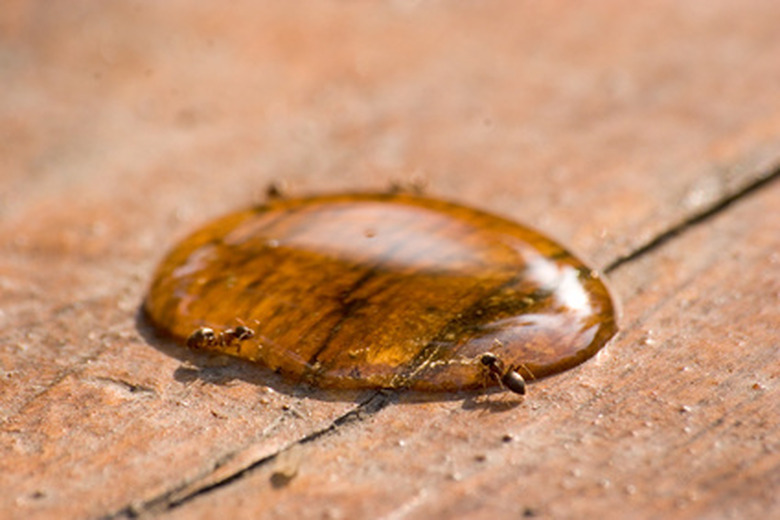Facts On Honey Pot Ants
Honeypot ants, also known as honey ants (Myrmecocystus sp.), get their name because some of the worker ants store large amounts of food in their crops, making them look like living, breathing honeypots. However, only certain ants within the colony become "honeypots." These ants are typically called repletes and hang from the ants' nest ceilings, feeding the other ants when food is scarce.
Ant Colony Caste Structure
Ant Colony Caste Structure
Ant colonies have complex social organizations that work together like a superorganism. Queen ants are at the core of a colony. The queen lays eggs that develop into either female workers, male ants or new queens. Each of these types of ants is called a caste.
Male ants only live for a few weeks and have wings to fly. Once they have completed their metamorphosis into an adult male, they leave the nest searching for a new queen to mate with. After mating, the male ant dies.
Female worker ants are sterile and unable to reproduce; instead, they specialize in filling different roles within the colony. The roles of worker ants include foraging for food, acting as soldiers to protect the colony and tending to the larvae. Honeypot ants are unique in that they have the worker ants called repletes, whose purpose is to store food for the colony.
Honeypot Ant Habitat
Honeypot Ant Habitat
Honeypot ants live in the arid deserts of the southwestern United States, Mexico, Australia and Africa. In North America, these ants are prominent in the Great Basin, Mojave, Sonoran and Chihuahuan deserts. The ants live in colonies and build vast nests under the ground, where they are protected from the extreme temperature changes of the desert.
The replete worker ants are typically found in the deepest parts of the nest, where the soil is still partially moist throughout the year. This is thought to help keep them moist to prevent them from losing fluids through evaporation. Living in the deepest parts of the nest may also help protect them from invaders and predators.
Diet of Honeypot Ants
Diet of Honeypot Ants
Honeypot ants feed on other insects and the nectar of desert flowers. When food is plentiful during the rainy season, worker ants bring the nectar and insects killed by the colony into the nest. They then fill the replete ants' abdomens with the liquid sugars, lipids and proteins from the nectar and insects to save for later, like a larder. Once full, the replete ants are about the size of a grape.
When food is scarce during droughts, the replete worker ants feed their colony. Worker ants stroke the antennae of the replete ants to tell them to regurgitate some of the liquid food from their crop. The worker ant will then either eat the liquid herself or take the droplet and feed it to other colony members.
Wars Between Colonies
Wars Between Colonies
During times of drought, the replete ants are a valuable resource to keep the ant colony alive. Ant colonies usually live in peace, merely performing territorial displays to ward neighboring ants away. However, when one ant colony becomes considerably stronger than a neighboring colony, a tournament occurs. During a war, ants have been observed raiding their neighbors' nests, killing the queen then stealing off with repletes, larvae, pupae and callow workers to take back to feed their own colony.
Humans Eating Honeypot Ants
Humans Eating Honeypot Ants
Honeypot ants are edible and full of sugar, lipids and proteins. Digging for honeypot ants is a treasured tradition among women and children in Australian Aboriginal tribes. In 2017, famous Danish chef René Redzepi tried one and claimed they were the best thing he ate that year. In North America, animals such as badgers and coyotes also predate on honeypot ants.
References
- SBS Australia: These Sweet Australian Ants Are "The Best Honey You've Ever Tasted"
- Molecular Phylogenetics and Evolution: Comprehensive Phylogeny of Myrmecocystus Honey Ants Highlights Cryptic Diversity and Infers Evolution During Aridification of the American Southwest
- Arizona State University: Ask a Biologist: Individual Ant Life Cycle
- Navajo Nature: Myrmecocystus Mexicanus Wesmael
Cite This Article
MLA
Jerrett, Adrianne. "Facts On Honey Pot Ants" sciencing.com, https://www.sciencing.com/facts-on-honey-pot-ants-13406475/. 30 September 2021.
APA
Jerrett, Adrianne. (2021, September 30). Facts On Honey Pot Ants. sciencing.com. Retrieved from https://www.sciencing.com/facts-on-honey-pot-ants-13406475/
Chicago
Jerrett, Adrianne. Facts On Honey Pot Ants last modified March 24, 2022. https://www.sciencing.com/facts-on-honey-pot-ants-13406475/
